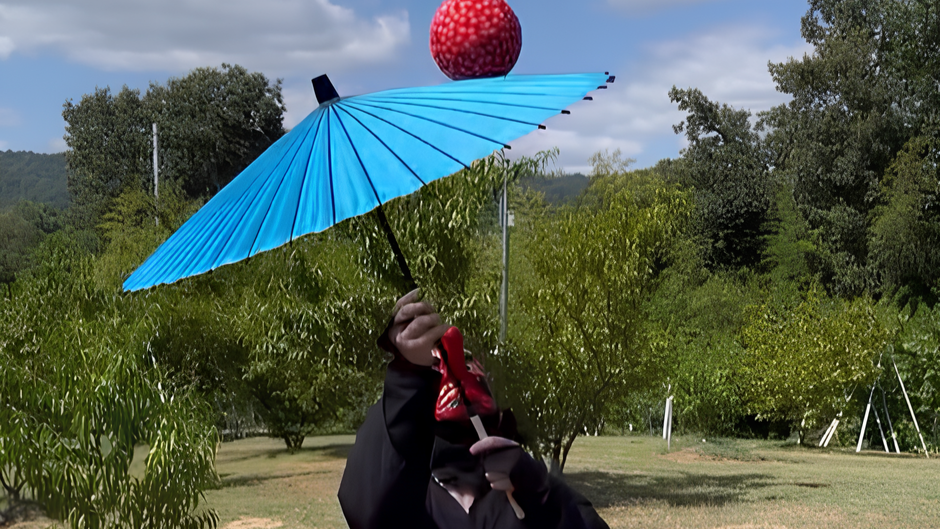忍忍者の変装術――七方出とは何か?
忍者とは、ただ影に隠れ潜む者ではなく、時には人々の目の前に現れながらも、その正体を悟られぬ者であった。そのため、忍者にとって「変装」は極めて重要な技術であり、中でも「七方出(しちほうで)」と呼ばれる変装術は、敵地での情報収集や潜入活動において欠かせぬものであった。
本日は、この「七方出」がどのような忍術書に記され、どのように活用されたのかを詳しく紐解いていくとしようかの。
七方出が記された忍術書
「七方出」は、1681年に紀州藩の軍学者、名取正澄によって著された『正忍記(しょうにんき)』に記されておる。『正忍記』は、『万川集海(ばんせんしゅうかい)』、『忍秘伝(にんぴでん)』と並び、三大忍術伝書と称される書物じゃ。この書には、忍者の心得、技術、道具の使い方などが幅広く網羅されており、その中で「七方出」は、敵地に潜入し、怪しまれずに情報を得るための技法として紹介されておるんじゃ。
七方出とは、忍者が七つの異なる身分に変装し、それぞれの特性を活かして行動する技術である。ただ衣装を変えるだけではなく、その職業や身分に必要な技術・話し方・振る舞いまでも習得し、本物になりきることで、敵に怪しまれることなく潜入を成功させたのじゃ。
七方出――七つの変装
忍者が用いた七方出には、次のような変装がある。
1. 虚無僧(こむそう)
尺八を吹きながら諸国を行脚する僧侶のことじゃ。天蓋(てんがい)と呼ばれる笠を深く被るため、顔を隠しながら行動することができるという利点があった。忍者は尺八の技術を習得し、行脚僧として堂々と敵地を歩きながら情報を集めたのじゃ。
2. 出家(しゅっけ)
僧侶の姿に扮し、寺院に出入りしながら情報を集める手法じゃ。ただし、僧侶には宗派ごとの作法や戒律があるため、それを理解し、適切に振る舞わねばならぬ。忍者は仏教の経典を暗記し、必要があれば説法を行うこともあったという。寺院は権力者との結びつきが強く、政治の動向を探るのに適した場所でもあった。
3. 山伏(やまぶし)
山岳修行を行う修験者の姿じゃ。山伏は霊験あらたかであると信じられ、各地を巡ることが許されていたため、忍者にとって理想的な変装の一つであった。山伏として護摩祈祷を行ったり、修験道の作法を身につけることで、敵地に潜入しやすくなったのじゃ。
4. 商人(あきんど)
交易のために旅をする商人は、最も怪しまれぬ身分の一つじゃ。忍者は商売の知識を持ち、実際に品物を売買しながら市場や宿場町で情報を集めた。酒や茶を交わしながらの世間話は、敵の動向を探る絶好の機会であったのじゃ。
5. 放下師(ほうかし)(曲芸人)
手品や曲芸、軽業を披露しながら旅をする芸人のことじゃ。忍者は傘回しやジャグリング、火吹きなどの芸を身につけ、見世物をしながら情報を集めた。人々の気を引き、警戒心を解くことで、自然と秘密を聞き出すことができたのじゃ。
6. 猿楽師(さるがくし)
猿楽とは、能の原型ともなる芸能の一つであり、滑稽な舞いや演劇を演じる者たちのことじゃ。城下町や貴族の館にも出入りできる身分であり、忍者が武家の屋敷に潜入する手段として用いられた。
7. 常の形(つねのかたち)(農民や武士)
農民や武士に変装することで、自然に敵地に溶け込む方法じゃ。農民として村に潜入し、領主の動向を探ることもあれば、武士に扮して城下町を歩きながら情報を得ることもあった。
変装の極意――ただの姿ではなく、なりきること
忍者の変装は、単に衣装を変えるだけでは通用せぬ。七方出において重要なのは、完全になりきることじゃ。それぞれの職業や身分に必要な技術や知識を持ち、話し方や動作までも本物のようにすることで、敵に怪しまれぬようにするのじゃ。
そして、この「七方出」の技術は、現代においても応用できるのじゃ。岡山忍者隊「葉隠」頭領の泡影(Awakage)は、まさに現代社会に生きる「七方出」の達人じゃ。複数の仕事を持ち、それぞれの場に応じて必要な技術を身につけ、自在に立ち回っておる。そして各地でさまざまな情報を集め、それを日々の業務や活動に活かしておるのじゃ。
七方出とは、時代を超えて生き抜く知恵そのもの。状況に応じて変化し、柔軟に対応することこそ、忍者の真の力といえよう。
まとめ
忍者の変装術「七方出」は、単なる衣装替えではなく、それぞれの職業や身分の専門知識を持ち、完全になりきることで敵に怪しまれずに潜入する技術であった。『正忍記』に記されたこの技術は、戦国の世を生き抜く忍びにとって欠かせぬものだったのじゃ。そして、その忍びの知恵は現代でも古臭くなるどころか益々輝きを増し、我々に学びをあたえてくれておる。
忍者とは、ただ戦う者ではなく、知識と知恵を駆使し、敵を欺きながら情報を操る者であったのじゃ。
【以下英語版】【English version below】
Ninja Disguise Techniques – What is Shichihōde?
A ninja is not merely one who hides in the shadows. At times, they would appear in plain sight, mingling with the people, yet never revealing their true identity. Because of this, disguise was an essential skill for ninjas. Among various disguise techniques, one of the most crucial was Shichihōde (七方出, “Seven Ways of Appearance”), a method that allowed ninjas to gather intelligence and infiltrate enemy territory undetected.
Today, let us delve into the origins of Shichihōde, examining which ninja manuals recorded it and how it was utilized in practice.
The Ninja Manual That Recorded Shichihōde
The technique of Shichihōde is documented in Shōninki (正忍記), a ninja manual written in 1681 by Natori Masazumi, a military strategist of the Kii Domain. Shōninki is considered one of the three great ninja manuals, alongside Bansenshūkai (万川集海) and Ninpiden (忍秘伝).
This book covers a wide range of ninja knowledge, including their philosophy, techniques, and the usage of various tools. Among these teachings, Shichihōde is introduced as an essential technique for infiltrating enemy territory and obtaining information without arousing suspicion.
Shichihōde allowed ninjas to assume seven different identities, each tailored for specific infiltration strategies. However, it was not merely about changing clothes—ninjas had to master the skills, speech, and mannerisms of their chosen disguise to blend in seamlessly with their surroundings.
The Seven Disguises of Shichihōde
The seven disguises used in Shichihōde were as follows:
1. Komusō (虚無僧, Itinerant Monk)
Komusō were monks who traveled while playing the shakuhachi flute. They wore a deep, basket-like hat called a tengai (天蓋), which concealed their faces. This disguise allowed ninjas to move freely without revealing their identity. Ninjas would train in playing the shakuhachi and roam as traveling monks, discreetly gathering intelligence.
2. Shukke (出家, Buddhist Monk)
By disguising themselves as Buddhist monks, ninjas could infiltrate temples and listen in on conversations. However, this was not a simple disguise—Buddhist monks followed strict rituals and customs. Ninjas had to study religious scriptures, memorize sutras, and even be capable of giving sermons if necessary. Temples often had ties to powerful feudal lords, making them valuable sources of political information.
3. Yamabushi (山伏, Mountain Ascetic)
Yamabushi were practitioners of Shugendō, an ancient ascetic tradition. Because they were believed to possess spiritual powers, they could travel freely between territories. Ninjas would learn Shugendō rituals, fire ceremonies, and how to blow the conch shell to perfect this disguise. By masquerading as a holy man, they could approach enemy strongholds without suspicion.
4. Akindo (商人, Merchant)
Merchants frequently traveled between different domains, making them one of the least suspicious identities. Ninjas who assumed this disguise needed business knowledge and could actually trade goods while gathering intelligence. Engaging in casual conversations over tea or sake provided them opportunities to extract crucial information from unwary locals and samurai.
5. Hōkashi (放下師, Street Performer)
Hōkashi were entertainers who traveled performing magic tricks, juggling, and acrobatics. Ninjas would train in umbrella spinning, fire breathing, and sleight of hand, using these skills to draw crowds. By lowering people’s guards through entertainment, they could listen in on conversations and gather intelligence.
6. Sarugakushi (猿楽師, Performer of Sarugaku Theater)
Sarugaku was a form of theatrical performance, a predecessor of modern Noh theater. Ninjas who mastered this craft could enter castles and noble residences under the pretext of performing for lords and high-ranking officials. This disguise allowed them to gather intelligence directly from within enemy strongholds.
7. Tsune no Katachi (常の形, Commoner or Samurai)
By disguising themselves as common villagers or samurai, ninjas could blend into enemy territory without drawing attention. As peasants, they could eavesdrop on rumors about feudal lords and political affairs. As samurai, they could move freely within castle towns, observing military preparations and strategies.
The True Art of Disguise – Becoming the Role
For a ninja, disguise was not merely about changing clothes. In Shichihōde, the key was to fully embody the chosen identity. They had to acquire the necessary skills, knowledge, and mannerisms to pass as a genuine member of that group.
This principle is not just a relic of the past. In today’s world, the art of adapting to different roles is a powerful skill. The head of the Okayama Ninja Team “Hagakure,” Awakage (泡影), is a modern-day master of Shichihōde.
By juggling multiple professions, acquiring specialized skills, and shifting personas depending on the situation, Awakage exemplifies the ninja’s ability to gather and utilize knowledge for strategic advantage. This is the true power of Shichihōde—a wisdom that transcends time and remains valuable even today.
Conclusion
Shichihōde, the ninja disguise technique, was not just about changing outfits. It was about mastering the behaviors, speech, and skills of a chosen identity to infiltrate enemy territory undetected. As described in Shōninki, this was an essential survival skill for ninjas during wartime.
Even in the modern world, the ability to adapt to different roles, acquire new knowledge, and blend into various environments is a crucial skill. The wisdom of the ninja continues to inspire us, showing that true strength lies not just in combat, but in intelligence and strategy.
A ninja was not merely a warrior, but a master of deception and knowledge, a manipulator of information who shaped the battlefield from the shadows.



